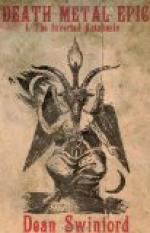With the Norman Conquest, French became the literary language of England, and modern romance was born. Romance cycles on “the matter of France” or Legends of Charlemagne, and on “the matter of Britain” or Legends of Arthur, became popular, and Geoffrey of Monmouth freely made use of his imagination to fill up the early history of Britain, for his so-called history is in reality a prose romance, whence later writers drew themes for many a tale.
Walter Map, born on the border of Wales in 1137, is credited with the no longer extant Latin prose romance of Lancelot du Lac, which included the Quest of the Holy Grail and the Death of Arthur. Besides Wace’s Brut, we have that of Layamon, and both poets not only explain how Britain’s name is derived from Brut,—a member of Priam’s family and refugee from Troy,—but go on to give the history of other early kings of Britain, including Arthur. They often touch the true epic note,—as in the wrestling match between Corineus and the giant,—use similes drawn from every-day life, and supply us with legends of King Lear and of Cymbeline.
It was toward the end of the twelfth century that Arthur reached the height of his renown as romantic hero, the “matter of Britain” having become international property, and having been greatly enriched by poets of many climes. By this time Arthur had ceased to be a king of Britain, to become king of a fairy-land and chief exponent of chivalric ideals and aims.
To name all the poets who had a share in developing the Arthurian Legend would prove an impossible task, but Nennius, Gildas, Geoffrey of Monmouth, Wace, Layamon, Benoit de St. Maur, Chrestien de Troyes, Marie de France, Hartmann von der Aue, and Wolfram von Eschenbach have, in English, French, and German, helped to develop the “matter of Britain,” and have managed to connect it with “the matter of France.”
During the age of metrical romances (1200 to 1500), all the already extant cycles were remodelled and extended. Besides, not only were Greek and Latin epics translated so as to be within reach of all, but one country freely borrowed from another. Thus, the French romances of Huon de Bordeaux and of the Four Sons of Aymon found many admirers in England, where the former later supplied Shakespeare with some of the characters for a Midsummer Night’s Dream. It was to offset the very popular romance of Alexander, that some patriotic poet evolved the romance of Richard Coeur de Lion, explaining how this king earned his well-known nickname by wrenching the heart out of a lion!
Some of these romances, such as Flores and Blancheflour, have “the voluptuous qualities of the East,” make great use of magic of all kinds, and show the idyllic side of love. The tragedy of love is depicted in the romance of Tristram and Iseult, where a love-potion plays a prominent part. But, although knightly love and valor are the stock topics, we occasionally come across a theme of Christian humility, like Sir Isumbras, or of democracy, as in the Squire of Low Degree and in the Ballads of Robin Hood.




